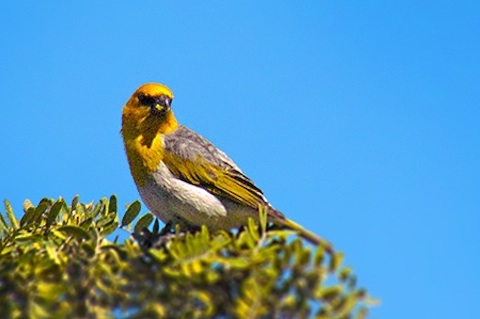|
|
|
Legal History—Palila goes to court
The Endangered Species Act of 1973 protects palila by providing for the conservation of ecosystems upon which threatened and endangered species of fish, wildlife, and plants depend, and prohibiting unauthorized taking, possession, sale, and transport of endangered species. Below is a summary of the colorful history of palila in court—the first species to ever be named as a plaintiff under the Endangered Species Act.

9th Circuit Judge Samuel King was the first Federal judge of Hawaiian ancestry.
[/one_fourth]
- 1967—Palila were listed as a Federally Protected Species as a result of a continued population decline due to the degradation of the habitat they depend on.
- 1973—Palila were listed as a Federally Endangered Species under the newly rewritten Endangered Species Act of 1973.
- 1978—The U.S. Fish and Wildlife Service designated Critical Habitat on Mauna Kea. Critical habitat is a specific geographic area(s) that is essential for the conservation of a threatened or endangered species and that may require special management and protection.
- 1979—The landmark case, Palila versus the Hawai‘i Department of Land and Natural Resources, federal judge Samuel King ordered the Hawai‘i Department of Land and Natural Resources to stop maintaining any populations of feral sheep and goats within palila critical habitat on Mauna Kea, and to completely and permanently remove feral sheep and goats from critical habitat.
- 1986—US District Court, Hawai‘i, decides that mouflon sheep in numbers sufficient for sport-hunting purposes are harmful to palila.
- 1987—US District Court, Hawai‘i, orders that state must eradicate mouflon sheep and hybrids within one year and reaffirms previous order to eradicate feral sheep and goats.
- 1998—Defendants and plaintiffs agree to a stipulation and order that DLNR will use its best efforts to minimize migration of ungulates into critical habitat, will continue to include public in eradication by eliminating bag limits and reducing seasonal restrictions and will allow hunting with firearms, guided hunts, and staff hunts, and will conduct semi-annual aerial hunts in which all ungulates seen will be shot.
- 1999—Hunter organizations intervene and with DLNR move to modify the 1987 order; US District Court, Hawai‘i, denies their motion. The request by the defendants to modify the decision was filed on the grounds that introduced predators were the culprits in the decline of the Palila, and that removal of the sheep would increase the risk of fire since the sheep help to reduce fuel loads from flashy grasses. The court affirmed that palila were endangered due to habitat loss from the sheep, that use of the sheep to reduce the fire risk would prevent forest recovery, and denied the motion to modify.
- 2000—Hunter organizations file an appeal of the 1999 decision; US Court of Appeals, Ninth Circuit, dismisses the appeal on the grounds that the group lacks standing.
- 2009—Earthjustice files motion to enforce the eradication orders of 1979, 1987, and 1998. In its arguments to the court, the State indicated that it would complete the fence work and complete the removal of the sheep in a timely manner.
|


